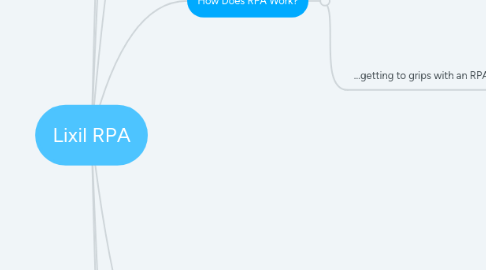
1. What Is RPA?
1.1. ...starting points...
1.1.1. There are four types of digital process automation...
1.1.1.1. ...demonstration...
1.1.1.1.1. Type 1. "Automation Integrated into Core Systems" - capability is written into the application itself...
1.1.1.1.2. Type 2. "Electronic Workflow and Business Process Management" - communication between families of applications, orchestrated from the "back-end"...
1.1.1.1.3. "Desktop Automation" - simple routines run from the laptop/desktop machine...
1.1.1.1.4. "Robotic Process Automation" - software bots performing semi-autonomous tasks at the "front-end", from a location in the cloud...
1.2. ...distinctive features of RPA...
1.2.1. RPA is a "low code" software-based bot that sits in the cloud...
1.2.2. ...it operates at the Front-End of systems, meaning it can communicate across and between typical technology boundaries (i.e. interoperability)...
1.2.3. ...it employs combinations of "Triggers", "Rules", and "Tasks" to achieve what it is designed to do...
1.2.3.1. ...more...
1.2.3.1.1. Interpreting Bots
1.2.4. ...typically it will perform combinations of simple tasks, freeing up humans to undertake more complicated activities.
1.3. ...an example of RPA...
1.3.1. Digital Media Requests
1.4. ...this leads us to a simple summary to begin with...
1.4.1. RPA Summary
1.5. ...the development of RPA...
1.5.1. Rules-Based RPA can be transformed into "Intelligence Process Automation" through the infusion of ML and AI...
1.5.2. ...the resulting IPA is able to perform "Cognitive" tasks within the RPA framework...
1.5.2.1. ...more...
1.5.2.1.1. UI Path Illustration
1.5.3. ...IPA is RPA that can Learn from Experience or exhibit human traits (e.g. See, Hear, Speak).
1.5.3.1. ...more...
1.5.3.1.1. Automation Anywhere Example
2. How Do We Design Processes To Automate?
2.1. Crib Sheet
2.2. Reading Deck
3. How do we Make RPA Work?
3.1. ...but RPA is not simply a "tech" issue...
3.1.1. A series of hard and soft side considerations count in order to make RPA work...
3.1.2. ...it is often these soft side factors that cause the greatest challenges.
3.1.2.1. ...more...
3.1.2.1.1. Barriers to Scale
3.2. ...process design discipline is required...
3.2.1. We have to be able to capture a process in terms of consistent, reliable "Trigger + Rules + Tasks" formats...
3.2.1.1. ...more...
3.2.1.1.1. RPA Design Process
3.3. ...new risks require new governance...
3.3.1. Generating the benefits of RPA requires us to get a grip of RPA Governance...
3.3.2. ...new roles and responsibilities are created as a result.
3.3.2.1. ...more...
3.3.2.1.1. Concept of "Attendance"
3.3.2.1.2. Human Roles in RPA
3.4. ...a summary...
3.4.1. Approaches to RPA Implementation
3.4.1.1. ...more...
3.4.1.1.1. Human Roles in RPA
3.5. ...we can highlight key steps...
3.5.1. Optimise the Process for Automation
3.5.1.1. ...considerations...
3.5.1.1.1. Translate to "Trigger + Rules + Task"
3.5.1.1.2. Reposition Bottlenecks and Limits to Speed
3.5.1.1.3. Define System Health and a Monitoring Plan
3.5.1.1.4. Identify Exceptions and Build-In Exceptions Handling Protocols
3.5.2. Establish Governance
3.5.2.1. ...considerations...
3.5.2.1.1. Attendance
3.5.2.1.2. Exceptions
3.5.2.1.3. Monitoring
3.5.2.1.4. Security
3.5.2.1.5. Accountability
4. How Does RPA Work?
4.1. ...RPA is typically a purchased solution...
4.1.1. An array of solution providers are available...
4.1.2. ...each solution typically combines three components.
4.1.2.1. ...more...
4.1.2.1.1. UI Path Components
4.1.2.1.2. UI Path Storefront
4.2. ...getting to grips with an RPA Studio...
4.2.1. UI Path
4.2.1.1. ...do or watch - exercises to illustrate how RPA bots work...
4.2.1.1.1. Tech Help - install UIPath Studio/StudioX on a Community License or Free Trial
4.2.1.1.2. Exercise #1. Excel to Web
4.2.1.1.3. Exercise #2. Currency Converter
4.2.1.1.4. Exercise #3. Excel to Word
5. Why is RPA Used?
5.1. ...the benefits of RPA are well established...
5.1.1. The principal RoI Statement of RPA blends Efficiency (i.e. Cost Savings) and Effectiveness (i.e. Quality Up or Errors Down)...
5.1.1.1. ...more...
5.1.1.1.1. Classic Business Case for RPA
5.1.1.1.2. Working of the RPA Business Case
5.1.2. ...often it is easier to realise Effectiveness before Efficiency.
5.2. ...RPA is often used because of practical considerations...
5.2.1. RPA is Fast to Deploy and Low Disruption (because it is Low Code and Front-End)...
5.2.1.1. ...more...
5.2.1.1.1. UI Path on Automation Costs
5.2.2. RPA can perform tasks across technology boundaries and between systems belonging to different families...
5.2.2.1. ...more...
5.2.2.1.1. SAP RPA Patterns
5.3. ...we can highlight key steps...
5.3.1. Establish an RoI
5.3.1.1. ...measures of success...
5.3.1.1.1. Efficiency
5.3.1.1.2. Effectiveness
6. Where is RPA Used?
6.1. ...principal purposes of RPA...
6.1.1. RPA is relevant wherever a process can be translated into a consistent and reliable "Trigger + Rule + Task" script...
6.1.1.1. ...a criteria for RPA...
6.1.1.1.1. Fully Digital
6.1.1.1.2. Rules-Based
6.1.1.1.3. Repetitive
6.1.1.1.4. High Burden
6.1.1.1.5. Consistent
6.1.1.1.6. Prone to Error
6.1.1.1.7. Quality Centric
6.1.1.1.8. Regulated
6.1.1.1.9. 24/7
6.1.1.2. ...more...
6.1.1.2.1. Processes Fit for RPA
6.1.2. ...but we do find RPA focussed in several areas...
6.1.2.1. ...more...
6.1.2.1.1. Lots of Attention in Finance and FSI
6.1.2.1.2. Automation Journey of a Bank
6.1.3. ...but RPA works wherever the criteria hold.
6.2. ...use of RPA in risk functions...
6.2.1. RPA is increasingly used to enhance the efficiency and effectiveness of risk management and internal audit processes.
6.2.1.1. ...more...
6.2.1.1.1. Examples of RPA in Risk
6.3. ...we can highlight key steps...
6.3.1. Identify a Process
6.3.1.1. ...a criteria for RPA...
6.3.1.1.1. Fully Digital
6.3.1.1.2. Rules-Based
6.3.1.1.3. Repetitive
6.3.1.1.4. High Burden
6.3.1.1.5. Consistent
6.3.1.1.6. Prone to Error
6.3.1.1.7. Quality Centric
6.3.1.1.8. Regulated
6.3.1.1.9. 24/7
6.3.1.2. ...more...
6.3.1.2.1. Selection Matrix
6.3.1.2.2. Workfusion Workflow
